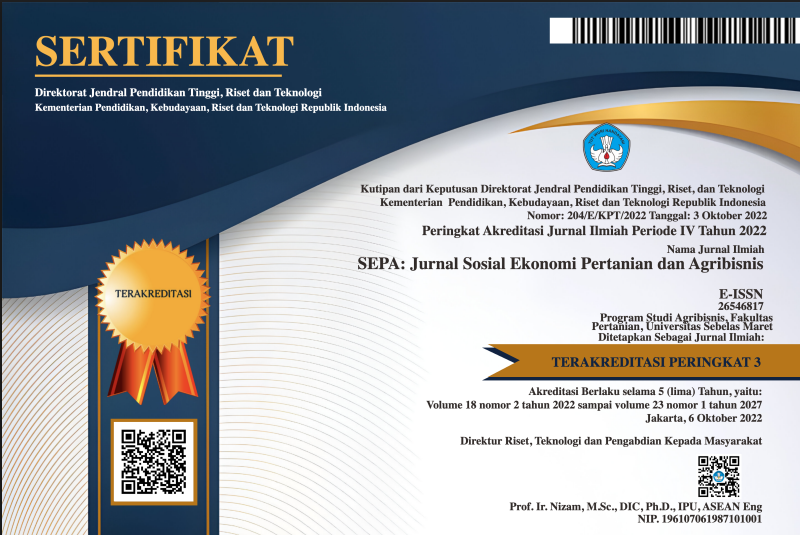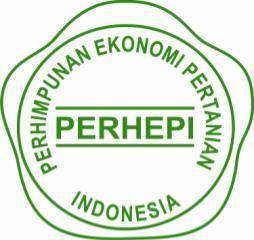THE EFFECT OF FERTILIZER AND AGRICULTURAL MACHINERY SUBSIDIES ON PADDY PRODUCTIVITY: A FEASIBLE GENERALIZED LEAST SQUARES APPROACH
Abstract
Paddy is a commodity that is widely cultivated by farmers in Indonesia. Paddy farmers are currently facing the threat of declining farm productivity due to land conversion activities, access to inputs that are difficult to reach, and climate change. However, productivity can be increased through the use of fertilizer inputs and agricultural machinery. Government support for paddy farmers is provided through input subsidies and agricultural machinery. Therefore, this study explores the effect of input subsidies and agricultural machinery on paddy productivity. We selected 20 provinces with the highest proportion of paddy fields to the total area. Feasible Generalized Least Squares (FGLS) analysis is used to determine the effect of subsidies on fertilizers and agricultural machinery on paddy productivity in Indonesia. The results showed that input subsidies were mostly allocated to Java, Sumatra, and Sulawesi islands, while agricultural machinery was allocated more to Sulawesi and Nusa Tenggara islands. FGLS analysis shows that the area of irrigated land, subsidies for urea fertilizer, subsidies for NPK fertilizers, subsidies for ZA fertilizers, and grants for 2-wheel tractors affect increasing paddy productivity. Meanwhile, the effect of increasing temperature causes a decrease in paddy productivity.
Keywords
Full Text:
PDFReferences
Abbas, S., & Mayo, Z. A. (2021). Impact of temperature and rainfall on rice production in Punjab, Pakistan. Environment, Development and Sustainability, 23(2), 1706–1728. https://doi.org/10.1007/s10668-020-00647-8
Abeyratne, F., & Takeshima, H. (2020). The evolution of agricultural mechanization in Sri Lanka. In an evolving paradigm of agricultural mechanization development: How much can Africa learn from Asia? (0 ed.). Washington, DC: International Food Policy Research Institute. https://doi.org/10.2499/9780896293809_04
Adeniyi, D. A., & Dinbabo, M. F. (2020). Efficiency, food security and differentiation in small-scale irrigation agriculture: Evidence from North West Nigeria. Cogent Social Sciences, 6(1), 1749508.https://doi.org/10.1080/23311886.2020.1749508
Agussabti, A., Romano, R., Rahmaddiansyah, R., & Isa, R. M. (2020). Factors affecting risk tolerance among small-scale seasonal commodity farmers and strategies for its improvement. Heliyon, 6(12), e05847 https://doi.org/10.1016/j.heliyon.2020.e05847
Akbar, I., Budiraharjo, K., & Mukson, M. (2018). Analisis faktor-faktor yang mempengaruhi produktivitas padi di Kecamatan Kesesi, Kabupaten Pekalongan. Agrisocionomics: Jurnal Sosial Ekonomi Pertanian, 1(2), 99–111. https://doi.org/10.14710/agrisocionomics.v1i2.1820
Ambarita, Y. (2017). Aplikasi pupuk NPK dan Urea pada padi (Oryza sativa l.) sistem ratun. Jurnal Produksi Tanaman, 5(7), 1228–1234.
Anggraeni, W., Andri, K. B., Sumaryanto, & Mahananto, F. (2017). The performance of ARIMAX model and vector autoregressive (VAR) model in forecasting strategic commodity price in Indonesia. Procedia Computer Science, 124, 189–196. Elsevier B.V. https://doi.org/10.1016/j.procs.2017.12.146
APPI. (2020). Fertilizer Consumption on Domestic Market and Export Market, year 2014—2020. Jakarta: Asosiasi Produsen Pupuk Indonesia
Asaad, Muh., Sugiman, S. B., Warda, N., & Abidin, Z. (2018). Analisis persepsi petani terhadap penerapan tanam jajar legowo padi sawah di Sulawesi Tenggara. Jurnal Pengkajian dan Pengembangan Teknologi Pertanian, 20(3), 197–208. https://doi.org/10.21082/jpptp.v20n3.2017.p197-208
Azmeri, A., Yulianur, A., Zahrati, U., & Faudli, I. (2019). Effects of irrigation performance on water balance: Krueng baro irrigation scheme (Aceh-Indonesia) as a case study. Journal of Water and Land Development, 42(1), 12–20. https://doi.org/10.2478/jwld-2019-0040
Bachrein, S., Ruswandi, A., & Subarna, T. (2009). Penggunaan traktor roda dua pada lahan padi sawah di Jawa Barat. Agrikultura, 20(3), 191–197. https://doi.org/10.24198/agrikultura.v20i3.955
Bai, J., Choi, S. H., & Liao, Y. (2021). Feasible generalized least squares for panel data with cross-sectional and serial correlations. Empirical Economics, 60(1), 309–326. https://doi.org/10.1007/s00181-020-01977-2
BPS. (2019). Hasil Survei Pertanian Antar Sensus (SUTAS) 2018 Seri-A2. Jakarta: Badan Pusat Statistik.
BPS. (2020). Statistik Indonesia 2020 (Subdirektorat Publikasi dan Kompilasi Statistik, Ed.). Jakarta: Badan Pusat Statistik.
Chalise, S., & Naranpanawa, A. (2016). Climate change adaptation in agriculture: A computable general equilibrium analysis of land-use change in Nepal. Land Use Policy, 59, 241–250. https://doi.org/10.1016/j.landusepol.2016.09.007
Damayanti, L. (2013). Faktor-faktor yang mempengaruhi produksi, pendapatan dan kesempatan kerja pada usaha tani padi sawah di daerah irigasi Parigi Moutong. SEPA, 9(2), 249–259.
Daulay, A. R., Eka Intan, K. P., Barus, B., & Pramudya, N. B. (2016). Rice land conversion into plantation crop and challenges on sustainable land use system in the East Tanjung Jabung Regency. Procedia - Social and Behavioral Sciences, 227, 174–180. https://doi.org/10.1016/j.sbspro.2016.06.059
De Marinis, P., & Sali, G. (2020). Participatory analytic hierarchy process for resource allocation in agricultural development projects. Evaluation and Program Planning, 80(February), 101793https://doi.org/10.1016/j.evalprogplan.2020.101793
Ding, Y., Wang, W., Zhuang, Q., & Luo, Y. (2020). Adaptation of paddy rice in China to climate change: The effects of shifting sowing date on yield and irrigation water requirement. Agricultural Water Management, 228, 105890. https://doi.org/10.1016/j.agwat.2019.105890
Frimawaty, E., Basukriadi, A., Syamsu, J. A., & Soesilo, T. E. B. (2013). Sustainability of rice farming based on eco-farming to face food security and climate change: Case study in Jambi Province, Indonesia. Procedia Environmental Sciences, 17, 53–59. https://doi.org/10.1016/j.proenv.2013.02.011
Guntukula, R., & Goyari, P. (2020). The impact of climate change on maize yields and its variability in Telangana, India: A panel approach study. Journal of Public Affairs, 20(3), 1–11. https://doi.org/10.1002/pa.2088
Hafizah, D., Hakim, D. B., Harianto, H., & Nurmalina, R. (2020). The role of rice’s price in the household consumption in Indonesia. Agriekonomika, 9(1), 38–47. https://doi.org/10.21107/agriekonomika.v9i1.6962
Hakim, R., Haryanto, T., & Sari, D. W. (2021). Technical efficiency among agricultural households and determinants of food security in East Java, Indonesia. Scientific Reports, 11(1), 1–9. https://doi.org/10.1038/s41598-021-83670-7
Haryanto, T., Talib, B. A., & Salleh, N. H. M. (2015). An analysis of technical efficiency variation in Indonesian rice farming. Journal of Agricultural Science, 7(9), 144–153. https://doi.org/10.5539/jas.v7n9p144
Hemming, D. J., Chirwa, E. W., Dorward, A., Ruffhead, H. J., Hill, R., Osborn, J., … Phillips, D. (2018). Agricultural input subsidies for improving productivity, farm income, consumer welfare and wider growth in low‐ and lower‐middle‐income countries: A systematic review. Campbell Systematic Reviews, 14(1), 1–153. https://doi.org/10.4073/csr.2018.4
Herve, D. S., Annih, M. G., Kenyi, M. D., & Christopher Suh. (2017). Effect of different doses of NPK fertilizer on the growth and yield of rice in Ndop, North West of Cameroon. African Journal of Agricultural Research, 12(15), 1244–1252. https://doi.org/10.5897/AJAR2017.12127
Hikmatullah, H., & Suryani, E. (2014). Potensi sumberdaya lahan Pulau Sulawesi mendukung peningkatan produksi padi, jagung, dan kedele. Jurnal Sumberdaya Lahan Edisi Khusus, 8(3), 41–56.http://dx.doi.org/10.21082/jsdl.v8n3.2014.%25p
IPCC. (2014). Climate Change 2014: Synthesis Report. Geneva, Switzerland: Intergovernmental Panel on Climate Change.
Irawan, B. (2013). Profil Wilayah Sentra Padi di Pulau Sulawesi. In Kemandirian Pangan Indonesia Dalam Persektif Kebijakan MP3EI (pp. 559–586). Jakarta: IAARD Press.
Jiang, Z., Zhong, Y., Yang, J., Wu, Y., Li, H., & Zheng, L. (2019). Effect of nitrogen fertilizer rates on carbon footprint and ecosystem service of carbon sequestration in rice production. Science of The Total Environment, 670, 210–217. https://doi.org/10.1016/j.scitotenv.2019.03.188
Koirala, K. H., Mishra, A., & Mohanty, S. (2016). Impact of land ownership on productivity and efficiency of rice farmers: The case of the Philippines. Land Use Policy, 50, 371–378. https://doi.org/10.1016/j.landusepol.2015.10.001
Laborde, D., Mamun, A., Martin, W., Piñeiro, V., & Vos, R. (2021). Agricultural subsidies and global greenhouse gas emissions. Nature Communications, 12(1), 1–9. https://doi.org/10.1038/s41467-021-22703-1
Matchaya, G. C. (2020). Public spending on agriculture in Southern Africa: Sectoral and intra-sectoral impact and policy implications. Journal of Policy Modeling, 42(6), 1228–1247. https://doi.org/10.1016/j.jpolmod.2020.05.002
Miah, Md. A. M., Gaihre, Y. K., Hunter, G., Singh, U., & Hossain, S. A. (2016). Fertilizer deep placement increases rice production: Evidence from farmers’ fields in Southern Bangladesh. Agronomy Journal, 108(2), 805–812. https://doi.org/10.2134/agronj2015.0170
Murthy, K. M. D., Rao, A. U., Vijay, D., & Sridhar, T. V. (2015). Effect of levels of nitrogen, phosphorus and potassium on performance of rice. Indian Journal of Agricultural Research, 49(1), 83–87. https://doi.org/10.5958/0976-058X.2015.00012.8
Nugroho, A. D., Waluyati, L. R., & Jamhari, J. (2018). Upaya memikat generasi muda bekerja pada sektor pertanian di Daerah Istimewa Yogyakarta. JPPUMA: Jurnal Ilmu Pemerintahan dan Sosial Politik Universitas Medan Area, 6(1), 76–95. https://doi.org/10.31289/jppuma.v6i1.1252
Panuju, D. R., Mizuno, K., & Trisasongko, B. H. (2013). The dynamics of rice production in Indonesia 1961–2009. Journal of the Saudi Society of Agricultural Sciences, 12(1), 27–37. https://doi.org/10.1016/j.jssas.2012.05.002
Paudel, G. P., Kc, D. B., Rahut, D. B., Justice, S. E., & McDonald, A. J. (2019). Scale-appropriate mechanization impacts on productivity among smallholders: Evidence from rice systems in the mid-hills of Nepal. Land Use Policy, 85, 104–113. https://doi.org/10.1016/j.landusepol.2019.03.030
Purwantini, T. B., & Susilowati, S. H. (2018). Dampak penggunaan alat mesin panen terhadap kelembagaan usaha tani padi. Analisis Kebijakan Pertanian, 16(1), 73–88. https://doi.org/10.21082/akp.v16n1.2018.73-88
Pusdatin-Kementerian Pertanian. (2020). Statistik Konsumsi Pangan 2020. Jakarta: Kementerian Pertanian.
Ranathilaka, M. B., & Arachchi, I. A. J. I. (2019). The effect of fertilizer subsidy on paddy production of smallscale farmers: Special reference in Polonnaruwa Districtin Sri Lanka. Review of Behavioral Aspect in Organizations and Society, 1(1), 33–44. https://doi.org/10.32770/rbaos.vol133-44
Reed, W. R., & Ye, H. (2011). Which panel data estimator should i use? Applied Economics, 43(8), 985–1000. https://doi.org/10.1080/00036840802600087
Santoso, W. Y. (2015). Kebijakan nasional Indonesia dalam adaptasi dan mitigasi perubahan iklim. Hasanuddin Law Review, 1(3), 372–379. https://doi.org/10.20956/halrev.v1n3.116
Sinnarong, N., Chen, C.-C., McCarl, B., & Tran, B.-L. (2019). Estimating the potential effects of climate change on rice production in Thailand. Paddy and Water Environment, 17(4), 761–769. https://doi.org/10.1007/s10333-019-00755-w
Sudono, I., Utami, W., & Lestari, S. (2016). Pengelompokan produksi padi nasional dengan pendekatan data mining konsep k-means. Jurnal Irigasi, 8(2), 72–89. https://doi.org/10.31028/ji.v8.i2.72-89
Sunanto, S., & Rauf, A. W. (2018). Respon petani terhadap pelaksanaan displai padi gogo vub pada lahan sub optimal di Sulawesi Selatan. Jurnal Sosial Ekonomi Pertanian, 14(2), 143–160. https://doi.org/10.20956/jsep.v14i2.4377
Wang, W., Gong, J., Wang, Y., & Shen, Y. (2021). Exploring the effects of rural site conditions and household livelihood capitals on agricultural land transfers in China. Land Use Policy, 108(April), 105523.https://doi.org/10.1016/j.landusepol.2021.105523
Warr, P., & Yusuf, A. A. (2014). Fertilizer subsidies and food self-sufficiency in Indonesia. Agricultural Economics (United Kingdom), 45(5), 571–588. https://doi.org/10.1111/agec.12107
Zhang, W., Sheng, R., Zhang, M., Xiong, G., Hou, H., Li, S., & Wei, W. (2018). Effects of continuous manure application on methanogenic and methanotrophic communities and methane production potentials in rice paddy soil. Agriculture, Ecosystems & Environment, 258, 121–128. https://doi.org/10.1016/j.agee.2018.02.018
Zhao, C., Liu, B., Piao, S., Wang, X., Lobell, D. B., Huang, Y., … Asseng, S. (2017). Temperature increase reduces global yields of major crops in four independent estimates. Proceedings of the National Academy of Sciences, 114(35), 9326–9331. https://doi.org/10.1073/pnas.1701762114
DOI: https://doi.org/10.20961/sepa.v20i1.56237
Refbacks
- There are currently no refbacks.



.png)







.png)
3.png)





